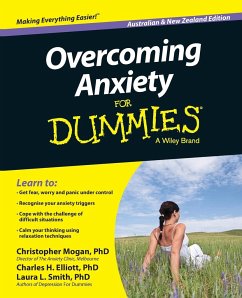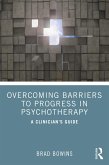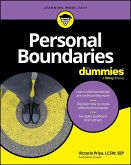24,99 €
inkl. MwSt.
Versandfertig in über 4 Wochen

12 °P sammeln
- Broschiertes Buch
- Merkliste
- Auf die Merkliste
- Bewerten Bewerten
- Teilen
- Produkt teilen
- Produkterinnerung
- Produkterinnerung
Learn to: * Get fear, worry and panic under control * Recognise your anxiety triggers * Cope with the challenge of difficult situations * Calm your thinking using relaxation techniques Keep anxiety under control and live a calmer, happier life Although it's perfectly normal to feel anxious every now and then, severe anxiety can be crippling -- especially if left untreated. Overcoming Anxiety For Dummies, Australian & New Zealand Edition, offers advice on the different forms of anxiety, practical strategies for changing your thinking to avoid panic attacks, and much more. If anxiety is…mehr
Andere Kunden interessierten sich auch für
![Humanising Mental Health Care in Australia Humanising Mental Health Care in Australia]() Humanising Mental Health Care in Australia181,99 €
Humanising Mental Health Care in Australia181,99 €![Overcoming Barriers to Progress in Psychotherapy Overcoming Barriers to Progress in Psychotherapy]() Brad BowinsOvercoming Barriers to Progress in Psychotherapy30,99 €
Brad BowinsOvercoming Barriers to Progress in Psychotherapy30,99 €![Personal Boundaries for Dummies Personal Boundaries for Dummies]() Victoria PriyaPersonal Boundaries for Dummies23,99 €
Victoria PriyaPersonal Boundaries for Dummies23,99 €![Understanding and Overcoming Misophonia Understanding and Overcoming Misophonia]() Thomas H DozierUnderstanding and Overcoming Misophonia14,99 €
Thomas H DozierUnderstanding and Overcoming Misophonia14,99 €![Overcoming Insomnia Therapist Guide Overcoming Insomnia Therapist Guide]() Jack D. EdingerOvercoming Insomnia Therapist Guide56,99 €
Jack D. EdingerOvercoming Insomnia Therapist Guide56,99 €![Novel Approaches for Overcoming Biological Barriers Novel Approaches for Overcoming Biological Barriers]() Novel Approaches for Overcoming Biological Barriers100,99 €
Novel Approaches for Overcoming Biological Barriers100,99 €![Overcoming Knee Osteoarthritis Overcoming Knee Osteoarthritis]() Neha DasareOvercoming Knee Osteoarthritis26,99 €
Neha DasareOvercoming Knee Osteoarthritis26,99 €-
-
-
Learn to: * Get fear, worry and panic under control * Recognise your anxiety triggers * Cope with the challenge of difficult situations * Calm your thinking using relaxation techniques Keep anxiety under control and live a calmer, happier life Although it's perfectly normal to feel anxious every now and then, severe anxiety can be crippling -- especially if left untreated. Overcoming Anxiety For Dummies, Australian & New Zealand Edition, offers advice on the different forms of anxiety, practical strategies for changing your thinking to avoid panic attacks, and much more. If anxiety is interfering with your everyday life, or affecting your friends and family, this book is for you. * Not just a worry wart -- get to know the types of anxiety disorders such as social anxiety, panic disorder, agoraphobia and post-traumatic stress disorder * Become a thought detective -- discover how to distinguish thoughts from feelings and cultivate calm thinking * Look at your lifestyle -- manage anxiety with exercise, good sleep, nutrition, mindfulness, and more * Challenge your anxious beliefs -- temper perfectionist tendencies, calm the approval addict, balance vulnerability, relax control and reduce dependency * Dig out the roots of anxiety -- clear the roadblocks to change by finding self-acceptance, facing your fears and seeking help from others Open the book and find: * How to identify symptoms * Details about the biology of anxiety and panic attacks * Tips for identifying and tracking your 'worry words' * Ways to treat anxiety with physical and medical remedies * Methods for using breathing to release tension * Strategies for dealing with work worries or financial woes * Ways to help friends and family manage their anxiety * Organisations that offer help and support
Hinweis: Dieser Artikel kann nur an eine deutsche Lieferadresse ausgeliefert werden.
Hinweis: Dieser Artikel kann nur an eine deutsche Lieferadresse ausgeliefert werden.
Produktdetails
- Produktdetails
- Verlag: Wiley
- Australian and New Zealand edition
- Seitenzahl: 384
- Erscheinungstermin: 21. Oktober 2014
- Englisch
- Abmessung: 235mm x 191mm x 21mm
- Gewicht: 719g
- ISBN-13: 9780730308768
- ISBN-10: 0730308766
- Artikelnr.: 41607820
- Herstellerkennzeichnung
- Produktsicherheitsverantwortliche/r
- Europaallee 1
- 36244 Bad Hersfeld
- gpsr@libri.de
- Verlag: Wiley
- Australian and New Zealand edition
- Seitenzahl: 384
- Erscheinungstermin: 21. Oktober 2014
- Englisch
- Abmessung: 235mm x 191mm x 21mm
- Gewicht: 719g
- ISBN-13: 9780730308768
- ISBN-10: 0730308766
- Artikelnr.: 41607820
- Herstellerkennzeichnung
- Produktsicherheitsverantwortliche/r
- Europaallee 1
- 36244 Bad Hersfeld
- gpsr@libri.de
Christopher Mogan, PhD, is the director of an Intensive Outpatient Program for OCD and related disorders at The Anxiety Clinic in Melbourne. Charles H. Elliott, PhD, and Laura L. Smith, PhD, are clinical psychologists who specialise in the treatment of anxiety and mood disorders.
Introduction 1
About This Book 2
Foolish Assumptions 3
Icons Used in This Book 3
Beyond the Book 4
Where to Go from Here 4
Part I: Understanding Anxiety 5
Chapter 1: Showing How Anxiety Affects Our Lives 7
Anxiety: Everybody's Doing It 8
Calculating the Costs of Anxiety 9
What does anxiety cost you? 9
Adding up the cost to society 10
Recognising the Symptoms of Anxiety 11
Thinking anxiously 11
Behaving anxiously 12
Finding anxiety in your body 12
Seeking Help for Your Anxiety 13
Matching symptoms and therapies 14
Choosing where to start 16
Finding the right help 18
Chapter 2: Examining Anxiety: What's Normal, What's Not 19
Knowing When Anxiety Is a Help and When It's a Hindrance 20
Presenting the Different Types of Anxiety 21
Generalised anxiety disorder: The common cold of anxiety 21
Social anxiety disorder: Avoiding people 23
Panic disorder: Way beyond everyday anxiety 24
Agoraphobia: Panic's companion 27
Specific phobias: Spiders, snakes, airplanes and other scary things 28
Post-traumatic stress disorder: Feeling the effects of trauma and terror 30
Obsessive-compulsive disorder: Over and over and over again 32
Seeing How Anxiety Differs from Other Disorders 34
Chapter 3: Sorting Through the Brain and Biology 37
Examining the Anxious Brain 37
Seeing how the brain's circuits are connected 38
Communicating chemicals 38
Preparing to Fight, Flee or Freeze 39
Mimicking Anxiety: Drugs, Diet and Diseases 42
Exploring anxiety-mimicking drugs 42
Ingesting anxiety from your diet 44
Investigating medical anxiety imposters 46
Chapter 4: Clearing the Roadblocks to Change 49
Looking for Where Your Anxiety Started 49
It's in my genes! 51
It's how I was raised! 51
It's the world's fault! 52
Finding Self-Acceptance 53
Having Second Thoughts about Change 55
Deciding to Get the Show on the Road 57
Arguing with your arguments 57
Taking things one step at a time 58
Watching Worries Come and Go 60
Following your fears 61
Writing about your worries 62
Reducing Your Sensitivity to Anxiety 64
Getting Help from Others 65
Seeking the right therapies 65
Seeking the right therapist 66
Part II: A Working Model for Your Anxiety 69
Chapter 5: Becoming a Thought Detective 71
Distinguishing Thoughts from Feelings 72
Blocking the blues 72
Getting in touch with your feelings 74
Getting in touch with your thoughts 76
Tracking How Thoughts, Feelings and Behaviour Interact 79
Tackling Your Thoughts: Thought Therapy 81
Weighing the evidence: Thought court 81
Rethinking risk 83
Deconstructing worrying scenarios 85
Cultivating Calm Thinking 90
Considering a 'friend's' perspective 91
Creating calm 92
Stepping back from negative thinking 93
Chapter 6: Watching Out for Worry Words 95
Stacking Sticks into Bonfires of Anxiety 95
Encountering extremist words 96
Misrepresenting with all-or-none, black-or-white words 98
Running into judging words 99
Turning to victim words 100
Tracking Your Worry Words 101
Refuting and Replacing Your Worry Words 102
Exorcising your extremist words 103
Disputing all-or-none 103
Judging the judge 104
Vanquishing victim words 105
Chapter 7: Challenging Your Agitating Assumptions 107
Understanding Agitating Assumptions 108
Sizing Up Agitating Assumptions 109
Recognising schemas 109
Assessing your agitating assumptions 110
Coming Down with a Case of Anxious Schemas 112
Acquiring assumptions in childhood 112
Shattering your reasonable assumptions 113
Unravelling Those Nasty Assumptions: Running a Cost/Benefit Analysis 115
Analysing perfection 116
Rating approval-seeking 118
Reviewing vulnerability 119
Counting up control 120
Debating dependency 121
Unravelling your own agitating assumptions 122
Designing Calm, Balanced Assumptions 123
Tempering perfectionist tendencies 124
Balancing an approval addict 124
Balancing vulnerability 126
Relaxing control 126
Diminishing dependency 127
Above All: Be Kind to Yourself! 128
Chapter 8: Facing Fear One Step at a Time 129
Exposure: Going Head-to-Head With Your Fears 129
Getting ready by relaxing 130
Understanding your fears 133
Constructing a staircase of fear135
Imagining the worst 137
Facing your fears138
Tackling All Types of Fears 140
Waging war on worry: GAD 141
Fighting specific and social phobias 142
Pushing through panic and agoraphobia 144
Processing post-traumatic stress disorder 146
Reversing obsessive-compulsive disorder 148
Chapter 9: Considering Medications and Other Physical Treatment Options 153
Taking Advice About Medications 154
The downside of medications 155
The upside of medications155
Understanding Medication Options 156
Antidepressants 157
Benzodiazepines 161
Miscellaneous tranquillisers 163
Beta-blockers 164
Atypical antipsychotics 164
Mood stabilisers 166
A few intriguing medication options 166
Searching for Supplements 167
Viva vitamins! 169
Sifting through the slew of supplements 169
Stimulating the Brain 172
Deep brain stimulation 172
Transcranial magnetic stimulation 172
Part III: Seeing Anxiety as a Part of Life 173
Chapter 10: Looking at Lifestyle 175
Friends and Family - Can't Live with 'em, Can't Live without 'em 175
Staying connected with others 176
Delegating creates extra time 177
Just saying 'no' 178
Ready ... Exorcise! 179
Don't wait for willpower - just do it! 180
Working in your workout 181
The ABCs of Getting Good Sleep 182
Creating a sleep haven 183
Following a few relaxing routines 184
What to do when sleep just won't come 186
Designing Calm Diets 187
Enjoying small, frequent portions 187
Following nutritional common sense 188
Chapter 11: Relaxation: The Five-Minute Solution 189
Breathing Anxiety Away 190
Discovering your natural breathing pattern 191
Breathing like a baby 192
Using panic breathing in high-stress situations 194
Relaxing Your Whole Body 194
Knowing what to expect 195
Discovering the progressive muscle technique 196
Applying Relaxation in Tense Situations 198
Relaxing through Your Senses 199
Sounds to soothe the savage beast 199
Only the nose knows for sure 200
Massaging away stress 201
Chapter 12: Calming the Mind 203
Letting Your Imagination Roam 204
Imagining touch 205
Recalling sounds 206
Remembering tastes 207
Conjuring up smells 207
Painting pictures in your mind 208
Full Sensory Imaging 210
Relaxing at the beach 210
A rainforest fantasy 211
Customising Your Own Images 212
Chapter 13: Mindful Acceptance 213
Accepting Anxiety? Hey, That's a Switch! 214
Taking a calm, dispassionate view 214
Tolerating uncertainty 216
Being patient with yourself 217
Letting Go of Ego 218
Inflating and deflating the self-esteem balloon 219
Appreciating your imperfections 220
Connecting with the Here and Now 222
Making contact with the present 224
Putting worries about the future to rest 226
Mindfully meditating 226
Accepting Mindfulness into Your Life 229
Building on Your Values 229
Part IV: Zeroing In on Specific Worries 231
Chapter 14: Facing a Career Crisis and Financial Woes 233
Meeting Job Worries Head-On 234
Updating your resume 234
Finding flexibility in your career view 235
Considering careers with stability 237
Keeping the right focus 238
Taking Stock of Your Resources 239
Tallying up your financial balance sheet 239
Knowing your personal assets and liabilities 240
Committing to a New Game Plan 241
Setting short-term goals 241
Planning for the long haul 242
Chapter 15: Keeping Steady When the World Is Shaking 245
Assessing Your Risks 246
Looking at the likelihood of dying from a natural disaster 246
Thinking sensibly about your personal risks 248
Preparing a Plan for Risk Management 248
Imagining and Dealing with the Worst 251
Rethinking uncertainty and anxiety 252
Rethinking your ability to cope 252
Facing, not avoiding, your worries 254
Doing Your Part to Improve the World 256
Helping the environment 256
Volunteering in disasters 257
Chapter 16: Staying Healthy 259
Examining the Connection between Worry and Health 259
Recalculating the Costs and Benefits of Health Worry 261
Reviewing the Risks of the Modern World 263
Examining the evolving realities of diseases and treatments 263
Weighing local versus global health risks 265
Watching out for exaggerated claims 266
Taking an Inventory of Your Personal Health 267
Checking out your lifestyle 267
Accepting your genetic risks 268
Designing a Health Action Plan 268
Chapter 17: Knowing Your 'High Risk' Situations 271
Evaluating Your Actual, Personal Risks 271
Maximising Your Preparedness 272
Taking charge of personal safety 273
Avoiding unnecessary risks 273
Dealing with Trauma 274
Thinking through what happened 276
Exposing yourself to the incident 277
Learning to Tolerate Uncertainty 278
Choosing to put yourself in high-risk situations 278
Experiencing danger in everyday places 279
Part V: Helping Others with Anxiety 283
Chapter 18: When a Family Member or Friend Suffers from Anxiety 285
Discovering Whether Your Loved One Suffers from Anxiety 286
Talking Together about Anxiety 288
Communicating with empathy 289
Avoiding blame 290
When help turns into harm 290
Guiding the Way 292
Coaching the right way 293
Looking at a coach in action 296
Teaming Up against Anxiety 298
Accepting Anxiety with Love 299
Chapter 19: Recognising Anxiety in Children 301
Separating Normal from Abnormal 301
Inspecting the Most Common Childhood Anxiety Disorders 304
Leaving parents: Separation anxiety disorder 305
Worrying all the time: Generalised anxiety disorder 307
Focusing on phobias: Specific phobias 307
Connecting with others: Social anxiety disorder 307
Anxious repetition: Obsessive-compulsive disorder 308
Rare anxieties among children 309
Chapter 20: Helping Anxious Children and Adolescents 311
Nipping Anxiety in the Bud 311
Early mastery experiences 312
Fine-tuning emotions 313
Inoculating against anxiety 314
Taking precautions via parenting style 315
Helping Already Anxious Children 318
Helping yourself first 319
Modelling calmness 319
Leading children through anxiety 320
Relaxing to reduce anxiety 322
Reducing anxiety through activity 325
Practising strategies and skills 327
Getting Help from Others 329
Who to turn to for help 329
What to expect at the first session 330
What happens in therapy? 331
Part VI: The Part of Tens 333
Chapter 21: Ten Ways to Stop Anxiety Quickly 335
Breathing Out Your Anxiety 335
Talking with a Friend 336
Exercising Aerobically 336
Soothing the Body 336
Drinking Tea 337
Challenging Your Anxious Thinking 337
Listening to Music 338
Finding Distractions 338
Having Sex 338
Staying with the Moment 339
Chapter 22: Ten (Or So) Signs That You Need Professional Help 341
Having Suicidal Thoughts or Plans 342
Feeling Hopeless 342
Experiencing Anxiety and Depression Symptoms 342
Trying to No Avail 343
Struggling at Home 343
Having Major Problems at Work 343
Suffering from Severe Obsessions or Compulsions 344
Struggling with Post-Traumatic Stress Disorder 344
Going through Sleepless Nights 344
Getting High 345
How to Get the Help You Need 345
Appendix: Resources for You 347
Index 353
About This Book 2
Foolish Assumptions 3
Icons Used in This Book 3
Beyond the Book 4
Where to Go from Here 4
Part I: Understanding Anxiety 5
Chapter 1: Showing How Anxiety Affects Our Lives 7
Anxiety: Everybody's Doing It 8
Calculating the Costs of Anxiety 9
What does anxiety cost you? 9
Adding up the cost to society 10
Recognising the Symptoms of Anxiety 11
Thinking anxiously 11
Behaving anxiously 12
Finding anxiety in your body 12
Seeking Help for Your Anxiety 13
Matching symptoms and therapies 14
Choosing where to start 16
Finding the right help 18
Chapter 2: Examining Anxiety: What's Normal, What's Not 19
Knowing When Anxiety Is a Help and When It's a Hindrance 20
Presenting the Different Types of Anxiety 21
Generalised anxiety disorder: The common cold of anxiety 21
Social anxiety disorder: Avoiding people 23
Panic disorder: Way beyond everyday anxiety 24
Agoraphobia: Panic's companion 27
Specific phobias: Spiders, snakes, airplanes and other scary things 28
Post-traumatic stress disorder: Feeling the effects of trauma and terror 30
Obsessive-compulsive disorder: Over and over and over again 32
Seeing How Anxiety Differs from Other Disorders 34
Chapter 3: Sorting Through the Brain and Biology 37
Examining the Anxious Brain 37
Seeing how the brain's circuits are connected 38
Communicating chemicals 38
Preparing to Fight, Flee or Freeze 39
Mimicking Anxiety: Drugs, Diet and Diseases 42
Exploring anxiety-mimicking drugs 42
Ingesting anxiety from your diet 44
Investigating medical anxiety imposters 46
Chapter 4: Clearing the Roadblocks to Change 49
Looking for Where Your Anxiety Started 49
It's in my genes! 51
It's how I was raised! 51
It's the world's fault! 52
Finding Self-Acceptance 53
Having Second Thoughts about Change 55
Deciding to Get the Show on the Road 57
Arguing with your arguments 57
Taking things one step at a time 58
Watching Worries Come and Go 60
Following your fears 61
Writing about your worries 62
Reducing Your Sensitivity to Anxiety 64
Getting Help from Others 65
Seeking the right therapies 65
Seeking the right therapist 66
Part II: A Working Model for Your Anxiety 69
Chapter 5: Becoming a Thought Detective 71
Distinguishing Thoughts from Feelings 72
Blocking the blues 72
Getting in touch with your feelings 74
Getting in touch with your thoughts 76
Tracking How Thoughts, Feelings and Behaviour Interact 79
Tackling Your Thoughts: Thought Therapy 81
Weighing the evidence: Thought court 81
Rethinking risk 83
Deconstructing worrying scenarios 85
Cultivating Calm Thinking 90
Considering a 'friend's' perspective 91
Creating calm 92
Stepping back from negative thinking 93
Chapter 6: Watching Out for Worry Words 95
Stacking Sticks into Bonfires of Anxiety 95
Encountering extremist words 96
Misrepresenting with all-or-none, black-or-white words 98
Running into judging words 99
Turning to victim words 100
Tracking Your Worry Words 101
Refuting and Replacing Your Worry Words 102
Exorcising your extremist words 103
Disputing all-or-none 103
Judging the judge 104
Vanquishing victim words 105
Chapter 7: Challenging Your Agitating Assumptions 107
Understanding Agitating Assumptions 108
Sizing Up Agitating Assumptions 109
Recognising schemas 109
Assessing your agitating assumptions 110
Coming Down with a Case of Anxious Schemas 112
Acquiring assumptions in childhood 112
Shattering your reasonable assumptions 113
Unravelling Those Nasty Assumptions: Running a Cost/Benefit Analysis 115
Analysing perfection 116
Rating approval-seeking 118
Reviewing vulnerability 119
Counting up control 120
Debating dependency 121
Unravelling your own agitating assumptions 122
Designing Calm, Balanced Assumptions 123
Tempering perfectionist tendencies 124
Balancing an approval addict 124
Balancing vulnerability 126
Relaxing control 126
Diminishing dependency 127
Above All: Be Kind to Yourself! 128
Chapter 8: Facing Fear One Step at a Time 129
Exposure: Going Head-to-Head With Your Fears 129
Getting ready by relaxing 130
Understanding your fears 133
Constructing a staircase of fear135
Imagining the worst 137
Facing your fears138
Tackling All Types of Fears 140
Waging war on worry: GAD 141
Fighting specific and social phobias 142
Pushing through panic and agoraphobia 144
Processing post-traumatic stress disorder 146
Reversing obsessive-compulsive disorder 148
Chapter 9: Considering Medications and Other Physical Treatment Options 153
Taking Advice About Medications 154
The downside of medications 155
The upside of medications155
Understanding Medication Options 156
Antidepressants 157
Benzodiazepines 161
Miscellaneous tranquillisers 163
Beta-blockers 164
Atypical antipsychotics 164
Mood stabilisers 166
A few intriguing medication options 166
Searching for Supplements 167
Viva vitamins! 169
Sifting through the slew of supplements 169
Stimulating the Brain 172
Deep brain stimulation 172
Transcranial magnetic stimulation 172
Part III: Seeing Anxiety as a Part of Life 173
Chapter 10: Looking at Lifestyle 175
Friends and Family - Can't Live with 'em, Can't Live without 'em 175
Staying connected with others 176
Delegating creates extra time 177
Just saying 'no' 178
Ready ... Exorcise! 179
Don't wait for willpower - just do it! 180
Working in your workout 181
The ABCs of Getting Good Sleep 182
Creating a sleep haven 183
Following a few relaxing routines 184
What to do when sleep just won't come 186
Designing Calm Diets 187
Enjoying small, frequent portions 187
Following nutritional common sense 188
Chapter 11: Relaxation: The Five-Minute Solution 189
Breathing Anxiety Away 190
Discovering your natural breathing pattern 191
Breathing like a baby 192
Using panic breathing in high-stress situations 194
Relaxing Your Whole Body 194
Knowing what to expect 195
Discovering the progressive muscle technique 196
Applying Relaxation in Tense Situations 198
Relaxing through Your Senses 199
Sounds to soothe the savage beast 199
Only the nose knows for sure 200
Massaging away stress 201
Chapter 12: Calming the Mind 203
Letting Your Imagination Roam 204
Imagining touch 205
Recalling sounds 206
Remembering tastes 207
Conjuring up smells 207
Painting pictures in your mind 208
Full Sensory Imaging 210
Relaxing at the beach 210
A rainforest fantasy 211
Customising Your Own Images 212
Chapter 13: Mindful Acceptance 213
Accepting Anxiety? Hey, That's a Switch! 214
Taking a calm, dispassionate view 214
Tolerating uncertainty 216
Being patient with yourself 217
Letting Go of Ego 218
Inflating and deflating the self-esteem balloon 219
Appreciating your imperfections 220
Connecting with the Here and Now 222
Making contact with the present 224
Putting worries about the future to rest 226
Mindfully meditating 226
Accepting Mindfulness into Your Life 229
Building on Your Values 229
Part IV: Zeroing In on Specific Worries 231
Chapter 14: Facing a Career Crisis and Financial Woes 233
Meeting Job Worries Head-On 234
Updating your resume 234
Finding flexibility in your career view 235
Considering careers with stability 237
Keeping the right focus 238
Taking Stock of Your Resources 239
Tallying up your financial balance sheet 239
Knowing your personal assets and liabilities 240
Committing to a New Game Plan 241
Setting short-term goals 241
Planning for the long haul 242
Chapter 15: Keeping Steady When the World Is Shaking 245
Assessing Your Risks 246
Looking at the likelihood of dying from a natural disaster 246
Thinking sensibly about your personal risks 248
Preparing a Plan for Risk Management 248
Imagining and Dealing with the Worst 251
Rethinking uncertainty and anxiety 252
Rethinking your ability to cope 252
Facing, not avoiding, your worries 254
Doing Your Part to Improve the World 256
Helping the environment 256
Volunteering in disasters 257
Chapter 16: Staying Healthy 259
Examining the Connection between Worry and Health 259
Recalculating the Costs and Benefits of Health Worry 261
Reviewing the Risks of the Modern World 263
Examining the evolving realities of diseases and treatments 263
Weighing local versus global health risks 265
Watching out for exaggerated claims 266
Taking an Inventory of Your Personal Health 267
Checking out your lifestyle 267
Accepting your genetic risks 268
Designing a Health Action Plan 268
Chapter 17: Knowing Your 'High Risk' Situations 271
Evaluating Your Actual, Personal Risks 271
Maximising Your Preparedness 272
Taking charge of personal safety 273
Avoiding unnecessary risks 273
Dealing with Trauma 274
Thinking through what happened 276
Exposing yourself to the incident 277
Learning to Tolerate Uncertainty 278
Choosing to put yourself in high-risk situations 278
Experiencing danger in everyday places 279
Part V: Helping Others with Anxiety 283
Chapter 18: When a Family Member or Friend Suffers from Anxiety 285
Discovering Whether Your Loved One Suffers from Anxiety 286
Talking Together about Anxiety 288
Communicating with empathy 289
Avoiding blame 290
When help turns into harm 290
Guiding the Way 292
Coaching the right way 293
Looking at a coach in action 296
Teaming Up against Anxiety 298
Accepting Anxiety with Love 299
Chapter 19: Recognising Anxiety in Children 301
Separating Normal from Abnormal 301
Inspecting the Most Common Childhood Anxiety Disorders 304
Leaving parents: Separation anxiety disorder 305
Worrying all the time: Generalised anxiety disorder 307
Focusing on phobias: Specific phobias 307
Connecting with others: Social anxiety disorder 307
Anxious repetition: Obsessive-compulsive disorder 308
Rare anxieties among children 309
Chapter 20: Helping Anxious Children and Adolescents 311
Nipping Anxiety in the Bud 311
Early mastery experiences 312
Fine-tuning emotions 313
Inoculating against anxiety 314
Taking precautions via parenting style 315
Helping Already Anxious Children 318
Helping yourself first 319
Modelling calmness 319
Leading children through anxiety 320
Relaxing to reduce anxiety 322
Reducing anxiety through activity 325
Practising strategies and skills 327
Getting Help from Others 329
Who to turn to for help 329
What to expect at the first session 330
What happens in therapy? 331
Part VI: The Part of Tens 333
Chapter 21: Ten Ways to Stop Anxiety Quickly 335
Breathing Out Your Anxiety 335
Talking with a Friend 336
Exercising Aerobically 336
Soothing the Body 336
Drinking Tea 337
Challenging Your Anxious Thinking 337
Listening to Music 338
Finding Distractions 338
Having Sex 338
Staying with the Moment 339
Chapter 22: Ten (Or So) Signs That You Need Professional Help 341
Having Suicidal Thoughts or Plans 342
Feeling Hopeless 342
Experiencing Anxiety and Depression Symptoms 342
Trying to No Avail 343
Struggling at Home 343
Having Major Problems at Work 343
Suffering from Severe Obsessions or Compulsions 344
Struggling with Post-Traumatic Stress Disorder 344
Going through Sleepless Nights 344
Getting High 345
How to Get the Help You Need 345
Appendix: Resources for You 347
Index 353
Introduction 1
About This Book 2
Foolish Assumptions 3
Icons Used in This Book 3
Beyond the Book 4
Where to Go from Here 4
Part I: Understanding Anxiety 5
Chapter 1: Showing How Anxiety Affects Our Lives 7
Anxiety: Everybody's Doing It 8
Calculating the Costs of Anxiety 9
What does anxiety cost you? 9
Adding up the cost to society 10
Recognising the Symptoms of Anxiety 11
Thinking anxiously 11
Behaving anxiously 12
Finding anxiety in your body 12
Seeking Help for Your Anxiety 13
Matching symptoms and therapies 14
Choosing where to start 16
Finding the right help 18
Chapter 2: Examining Anxiety: What's Normal, What's Not 19
Knowing When Anxiety Is a Help and When It's a Hindrance 20
Presenting the Different Types of Anxiety 21
Generalised anxiety disorder: The common cold of anxiety 21
Social anxiety disorder: Avoiding people 23
Panic disorder: Way beyond everyday anxiety 24
Agoraphobia: Panic's companion 27
Specific phobias: Spiders, snakes, airplanes and other scary things 28
Post-traumatic stress disorder: Feeling the effects of trauma and terror 30
Obsessive-compulsive disorder: Over and over and over again 32
Seeing How Anxiety Differs from Other Disorders 34
Chapter 3: Sorting Through the Brain and Biology 37
Examining the Anxious Brain 37
Seeing how the brain's circuits are connected 38
Communicating chemicals 38
Preparing to Fight, Flee or Freeze 39
Mimicking Anxiety: Drugs, Diet and Diseases 42
Exploring anxiety-mimicking drugs 42
Ingesting anxiety from your diet 44
Investigating medical anxiety imposters 46
Chapter 4: Clearing the Roadblocks to Change 49
Looking for Where Your Anxiety Started 49
It's in my genes! 51
It's how I was raised! 51
It's the world's fault! 52
Finding Self-Acceptance 53
Having Second Thoughts about Change 55
Deciding to Get the Show on the Road 57
Arguing with your arguments 57
Taking things one step at a time 58
Watching Worries Come and Go 60
Following your fears 61
Writing about your worries 62
Reducing Your Sensitivity to Anxiety 64
Getting Help from Others 65
Seeking the right therapies 65
Seeking the right therapist 66
Part II: A Working Model for Your Anxiety 69
Chapter 5: Becoming a Thought Detective 71
Distinguishing Thoughts from Feelings 72
Blocking the blues 72
Getting in touch with your feelings 74
Getting in touch with your thoughts 76
Tracking How Thoughts, Feelings and Behaviour Interact 79
Tackling Your Thoughts: Thought Therapy 81
Weighing the evidence: Thought court 81
Rethinking risk 83
Deconstructing worrying scenarios 85
Cultivating Calm Thinking 90
Considering a 'friend's' perspective 91
Creating calm 92
Stepping back from negative thinking 93
Chapter 6: Watching Out for Worry Words 95
Stacking Sticks into Bonfires of Anxiety 95
Encountering extremist words 96
Misrepresenting with all-or-none, black-or-white words 98
Running into judging words 99
Turning to victim words 100
Tracking Your Worry Words 101
Refuting and Replacing Your Worry Words 102
Exorcising your extremist words 103
Disputing all-or-none 103
Judging the judge 104
Vanquishing victim words 105
Chapter 7: Challenging Your Agitating Assumptions 107
Understanding Agitating Assumptions 108
Sizing Up Agitating Assumptions 109
Recognising schemas 109
Assessing your agitating assumptions 110
Coming Down with a Case of Anxious Schemas 112
Acquiring assumptions in childhood 112
Shattering your reasonable assumptions 113
Unravelling Those Nasty Assumptions: Running a Cost/Benefit Analysis 115
Analysing perfection 116
Rating approval-seeking 118
Reviewing vulnerability 119
Counting up control 120
Debating dependency 121
Unravelling your own agitating assumptions 122
Designing Calm, Balanced Assumptions 123
Tempering perfectionist tendencies 124
Balancing an approval addict 124
Balancing vulnerability 126
Relaxing control 126
Diminishing dependency 127
Above All: Be Kind to Yourself! 128
Chapter 8: Facing Fear One Step at a Time 129
Exposure: Going Head-to-Head With Your Fears 129
Getting ready by relaxing 130
Understanding your fears 133
Constructing a staircase of fear135
Imagining the worst 137
Facing your fears138
Tackling All Types of Fears 140
Waging war on worry: GAD 141
Fighting specific and social phobias 142
Pushing through panic and agoraphobia 144
Processing post-traumatic stress disorder 146
Reversing obsessive-compulsive disorder 148
Chapter 9: Considering Medications and Other Physical Treatment Options 153
Taking Advice About Medications 154
The downside of medications 155
The upside of medications155
Understanding Medication Options 156
Antidepressants 157
Benzodiazepines 161
Miscellaneous tranquillisers 163
Beta-blockers 164
Atypical antipsychotics 164
Mood stabilisers 166
A few intriguing medication options 166
Searching for Supplements 167
Viva vitamins! 169
Sifting through the slew of supplements 169
Stimulating the Brain 172
Deep brain stimulation 172
Transcranial magnetic stimulation 172
Part III: Seeing Anxiety as a Part of Life 173
Chapter 10: Looking at Lifestyle 175
Friends and Family - Can't Live with 'em, Can't Live without 'em 175
Staying connected with others 176
Delegating creates extra time 177
Just saying 'no' 178
Ready ... Exorcise! 179
Don't wait for willpower - just do it! 180
Working in your workout 181
The ABCs of Getting Good Sleep 182
Creating a sleep haven 183
Following a few relaxing routines 184
What to do when sleep just won't come 186
Designing Calm Diets 187
Enjoying small, frequent portions 187
Following nutritional common sense 188
Chapter 11: Relaxation: The Five-Minute Solution 189
Breathing Anxiety Away 190
Discovering your natural breathing pattern 191
Breathing like a baby 192
Using panic breathing in high-stress situations 194
Relaxing Your Whole Body 194
Knowing what to expect 195
Discovering the progressive muscle technique 196
Applying Relaxation in Tense Situations 198
Relaxing through Your Senses 199
Sounds to soothe the savage beast 199
Only the nose knows for sure 200
Massaging away stress 201
Chapter 12: Calming the Mind 203
Letting Your Imagination Roam 204
Imagining touch 205
Recalling sounds 206
Remembering tastes 207
Conjuring up smells 207
Painting pictures in your mind 208
Full Sensory Imaging 210
Relaxing at the beach 210
A rainforest fantasy 211
Customising Your Own Images 212
Chapter 13: Mindful Acceptance 213
Accepting Anxiety? Hey, That's a Switch! 214
Taking a calm, dispassionate view 214
Tolerating uncertainty 216
Being patient with yourself 217
Letting Go of Ego 218
Inflating and deflating the self-esteem balloon 219
Appreciating your imperfections 220
Connecting with the Here and Now 222
Making contact with the present 224
Putting worries about the future to rest 226
Mindfully meditating 226
Accepting Mindfulness into Your Life 229
Building on Your Values 229
Part IV: Zeroing In on Specific Worries 231
Chapter 14: Facing a Career Crisis and Financial Woes 233
Meeting Job Worries Head-On 234
Updating your resume 234
Finding flexibility in your career view 235
Considering careers with stability 237
Keeping the right focus 238
Taking Stock of Your Resources 239
Tallying up your financial balance sheet 239
Knowing your personal assets and liabilities 240
Committing to a New Game Plan 241
Setting short-term goals 241
Planning for the long haul 242
Chapter 15: Keeping Steady When the World Is Shaking 245
Assessing Your Risks 246
Looking at the likelihood of dying from a natural disaster 246
Thinking sensibly about your personal risks 248
Preparing a Plan for Risk Management 248
Imagining and Dealing with the Worst 251
Rethinking uncertainty and anxiety 252
Rethinking your ability to cope 252
Facing, not avoiding, your worries 254
Doing Your Part to Improve the World 256
Helping the environment 256
Volunteering in disasters 257
Chapter 16: Staying Healthy 259
Examining the Connection between Worry and Health 259
Recalculating the Costs and Benefits of Health Worry 261
Reviewing the Risks of the Modern World 263
Examining the evolving realities of diseases and treatments 263
Weighing local versus global health risks 265
Watching out for exaggerated claims 266
Taking an Inventory of Your Personal Health 267
Checking out your lifestyle 267
Accepting your genetic risks 268
Designing a Health Action Plan 268
Chapter 17: Knowing Your 'High Risk' Situations 271
Evaluating Your Actual, Personal Risks 271
Maximising Your Preparedness 272
Taking charge of personal safety 273
Avoiding unnecessary risks 273
Dealing with Trauma 274
Thinking through what happened 276
Exposing yourself to the incident 277
Learning to Tolerate Uncertainty 278
Choosing to put yourself in high-risk situations 278
Experiencing danger in everyday places 279
Part V: Helping Others with Anxiety 283
Chapter 18: When a Family Member or Friend Suffers from Anxiety 285
Discovering Whether Your Loved One Suffers from Anxiety 286
Talking Together about Anxiety 288
Communicating with empathy 289
Avoiding blame 290
When help turns into harm 290
Guiding the Way 292
Coaching the right way 293
Looking at a coach in action 296
Teaming Up against Anxiety 298
Accepting Anxiety with Love 299
Chapter 19: Recognising Anxiety in Children 301
Separating Normal from Abnormal 301
Inspecting the Most Common Childhood Anxiety Disorders 304
Leaving parents: Separation anxiety disorder 305
Worrying all the time: Generalised anxiety disorder 307
Focusing on phobias: Specific phobias 307
Connecting with others: Social anxiety disorder 307
Anxious repetition: Obsessive-compulsive disorder 308
Rare anxieties among children 309
Chapter 20: Helping Anxious Children and Adolescents 311
Nipping Anxiety in the Bud 311
Early mastery experiences 312
Fine-tuning emotions 313
Inoculating against anxiety 314
Taking precautions via parenting style 315
Helping Already Anxious Children 318
Helping yourself first 319
Modelling calmness 319
Leading children through anxiety 320
Relaxing to reduce anxiety 322
Reducing anxiety through activity 325
Practising strategies and skills 327
Getting Help from Others 329
Who to turn to for help 329
What to expect at the first session 330
What happens in therapy? 331
Part VI: The Part of Tens 333
Chapter 21: Ten Ways to Stop Anxiety Quickly 335
Breathing Out Your Anxiety 335
Talking with a Friend 336
Exercising Aerobically 336
Soothing the Body 336
Drinking Tea 337
Challenging Your Anxious Thinking 337
Listening to Music 338
Finding Distractions 338
Having Sex 338
Staying with the Moment 339
Chapter 22: Ten (Or So) Signs That You Need Professional Help 341
Having Suicidal Thoughts or Plans 342
Feeling Hopeless 342
Experiencing Anxiety and Depression Symptoms 342
Trying to No Avail 343
Struggling at Home 343
Having Major Problems at Work 343
Suffering from Severe Obsessions or Compulsions 344
Struggling with Post-Traumatic Stress Disorder 344
Going through Sleepless Nights 344
Getting High 345
How to Get the Help You Need 345
Appendix: Resources for You 347
Index 353
About This Book 2
Foolish Assumptions 3
Icons Used in This Book 3
Beyond the Book 4
Where to Go from Here 4
Part I: Understanding Anxiety 5
Chapter 1: Showing How Anxiety Affects Our Lives 7
Anxiety: Everybody's Doing It 8
Calculating the Costs of Anxiety 9
What does anxiety cost you? 9
Adding up the cost to society 10
Recognising the Symptoms of Anxiety 11
Thinking anxiously 11
Behaving anxiously 12
Finding anxiety in your body 12
Seeking Help for Your Anxiety 13
Matching symptoms and therapies 14
Choosing where to start 16
Finding the right help 18
Chapter 2: Examining Anxiety: What's Normal, What's Not 19
Knowing When Anxiety Is a Help and When It's a Hindrance 20
Presenting the Different Types of Anxiety 21
Generalised anxiety disorder: The common cold of anxiety 21
Social anxiety disorder: Avoiding people 23
Panic disorder: Way beyond everyday anxiety 24
Agoraphobia: Panic's companion 27
Specific phobias: Spiders, snakes, airplanes and other scary things 28
Post-traumatic stress disorder: Feeling the effects of trauma and terror 30
Obsessive-compulsive disorder: Over and over and over again 32
Seeing How Anxiety Differs from Other Disorders 34
Chapter 3: Sorting Through the Brain and Biology 37
Examining the Anxious Brain 37
Seeing how the brain's circuits are connected 38
Communicating chemicals 38
Preparing to Fight, Flee or Freeze 39
Mimicking Anxiety: Drugs, Diet and Diseases 42
Exploring anxiety-mimicking drugs 42
Ingesting anxiety from your diet 44
Investigating medical anxiety imposters 46
Chapter 4: Clearing the Roadblocks to Change 49
Looking for Where Your Anxiety Started 49
It's in my genes! 51
It's how I was raised! 51
It's the world's fault! 52
Finding Self-Acceptance 53
Having Second Thoughts about Change 55
Deciding to Get the Show on the Road 57
Arguing with your arguments 57
Taking things one step at a time 58
Watching Worries Come and Go 60
Following your fears 61
Writing about your worries 62
Reducing Your Sensitivity to Anxiety 64
Getting Help from Others 65
Seeking the right therapies 65
Seeking the right therapist 66
Part II: A Working Model for Your Anxiety 69
Chapter 5: Becoming a Thought Detective 71
Distinguishing Thoughts from Feelings 72
Blocking the blues 72
Getting in touch with your feelings 74
Getting in touch with your thoughts 76
Tracking How Thoughts, Feelings and Behaviour Interact 79
Tackling Your Thoughts: Thought Therapy 81
Weighing the evidence: Thought court 81
Rethinking risk 83
Deconstructing worrying scenarios 85
Cultivating Calm Thinking 90
Considering a 'friend's' perspective 91
Creating calm 92
Stepping back from negative thinking 93
Chapter 6: Watching Out for Worry Words 95
Stacking Sticks into Bonfires of Anxiety 95
Encountering extremist words 96
Misrepresenting with all-or-none, black-or-white words 98
Running into judging words 99
Turning to victim words 100
Tracking Your Worry Words 101
Refuting and Replacing Your Worry Words 102
Exorcising your extremist words 103
Disputing all-or-none 103
Judging the judge 104
Vanquishing victim words 105
Chapter 7: Challenging Your Agitating Assumptions 107
Understanding Agitating Assumptions 108
Sizing Up Agitating Assumptions 109
Recognising schemas 109
Assessing your agitating assumptions 110
Coming Down with a Case of Anxious Schemas 112
Acquiring assumptions in childhood 112
Shattering your reasonable assumptions 113
Unravelling Those Nasty Assumptions: Running a Cost/Benefit Analysis 115
Analysing perfection 116
Rating approval-seeking 118
Reviewing vulnerability 119
Counting up control 120
Debating dependency 121
Unravelling your own agitating assumptions 122
Designing Calm, Balanced Assumptions 123
Tempering perfectionist tendencies 124
Balancing an approval addict 124
Balancing vulnerability 126
Relaxing control 126
Diminishing dependency 127
Above All: Be Kind to Yourself! 128
Chapter 8: Facing Fear One Step at a Time 129
Exposure: Going Head-to-Head With Your Fears 129
Getting ready by relaxing 130
Understanding your fears 133
Constructing a staircase of fear135
Imagining the worst 137
Facing your fears138
Tackling All Types of Fears 140
Waging war on worry: GAD 141
Fighting specific and social phobias 142
Pushing through panic and agoraphobia 144
Processing post-traumatic stress disorder 146
Reversing obsessive-compulsive disorder 148
Chapter 9: Considering Medications and Other Physical Treatment Options 153
Taking Advice About Medications 154
The downside of medications 155
The upside of medications155
Understanding Medication Options 156
Antidepressants 157
Benzodiazepines 161
Miscellaneous tranquillisers 163
Beta-blockers 164
Atypical antipsychotics 164
Mood stabilisers 166
A few intriguing medication options 166
Searching for Supplements 167
Viva vitamins! 169
Sifting through the slew of supplements 169
Stimulating the Brain 172
Deep brain stimulation 172
Transcranial magnetic stimulation 172
Part III: Seeing Anxiety as a Part of Life 173
Chapter 10: Looking at Lifestyle 175
Friends and Family - Can't Live with 'em, Can't Live without 'em 175
Staying connected with others 176
Delegating creates extra time 177
Just saying 'no' 178
Ready ... Exorcise! 179
Don't wait for willpower - just do it! 180
Working in your workout 181
The ABCs of Getting Good Sleep 182
Creating a sleep haven 183
Following a few relaxing routines 184
What to do when sleep just won't come 186
Designing Calm Diets 187
Enjoying small, frequent portions 187
Following nutritional common sense 188
Chapter 11: Relaxation: The Five-Minute Solution 189
Breathing Anxiety Away 190
Discovering your natural breathing pattern 191
Breathing like a baby 192
Using panic breathing in high-stress situations 194
Relaxing Your Whole Body 194
Knowing what to expect 195
Discovering the progressive muscle technique 196
Applying Relaxation in Tense Situations 198
Relaxing through Your Senses 199
Sounds to soothe the savage beast 199
Only the nose knows for sure 200
Massaging away stress 201
Chapter 12: Calming the Mind 203
Letting Your Imagination Roam 204
Imagining touch 205
Recalling sounds 206
Remembering tastes 207
Conjuring up smells 207
Painting pictures in your mind 208
Full Sensory Imaging 210
Relaxing at the beach 210
A rainforest fantasy 211
Customising Your Own Images 212
Chapter 13: Mindful Acceptance 213
Accepting Anxiety? Hey, That's a Switch! 214
Taking a calm, dispassionate view 214
Tolerating uncertainty 216
Being patient with yourself 217
Letting Go of Ego 218
Inflating and deflating the self-esteem balloon 219
Appreciating your imperfections 220
Connecting with the Here and Now 222
Making contact with the present 224
Putting worries about the future to rest 226
Mindfully meditating 226
Accepting Mindfulness into Your Life 229
Building on Your Values 229
Part IV: Zeroing In on Specific Worries 231
Chapter 14: Facing a Career Crisis and Financial Woes 233
Meeting Job Worries Head-On 234
Updating your resume 234
Finding flexibility in your career view 235
Considering careers with stability 237
Keeping the right focus 238
Taking Stock of Your Resources 239
Tallying up your financial balance sheet 239
Knowing your personal assets and liabilities 240
Committing to a New Game Plan 241
Setting short-term goals 241
Planning for the long haul 242
Chapter 15: Keeping Steady When the World Is Shaking 245
Assessing Your Risks 246
Looking at the likelihood of dying from a natural disaster 246
Thinking sensibly about your personal risks 248
Preparing a Plan for Risk Management 248
Imagining and Dealing with the Worst 251
Rethinking uncertainty and anxiety 252
Rethinking your ability to cope 252
Facing, not avoiding, your worries 254
Doing Your Part to Improve the World 256
Helping the environment 256
Volunteering in disasters 257
Chapter 16: Staying Healthy 259
Examining the Connection between Worry and Health 259
Recalculating the Costs and Benefits of Health Worry 261
Reviewing the Risks of the Modern World 263
Examining the evolving realities of diseases and treatments 263
Weighing local versus global health risks 265
Watching out for exaggerated claims 266
Taking an Inventory of Your Personal Health 267
Checking out your lifestyle 267
Accepting your genetic risks 268
Designing a Health Action Plan 268
Chapter 17: Knowing Your 'High Risk' Situations 271
Evaluating Your Actual, Personal Risks 271
Maximising Your Preparedness 272
Taking charge of personal safety 273
Avoiding unnecessary risks 273
Dealing with Trauma 274
Thinking through what happened 276
Exposing yourself to the incident 277
Learning to Tolerate Uncertainty 278
Choosing to put yourself in high-risk situations 278
Experiencing danger in everyday places 279
Part V: Helping Others with Anxiety 283
Chapter 18: When a Family Member or Friend Suffers from Anxiety 285
Discovering Whether Your Loved One Suffers from Anxiety 286
Talking Together about Anxiety 288
Communicating with empathy 289
Avoiding blame 290
When help turns into harm 290
Guiding the Way 292
Coaching the right way 293
Looking at a coach in action 296
Teaming Up against Anxiety 298
Accepting Anxiety with Love 299
Chapter 19: Recognising Anxiety in Children 301
Separating Normal from Abnormal 301
Inspecting the Most Common Childhood Anxiety Disorders 304
Leaving parents: Separation anxiety disorder 305
Worrying all the time: Generalised anxiety disorder 307
Focusing on phobias: Specific phobias 307
Connecting with others: Social anxiety disorder 307
Anxious repetition: Obsessive-compulsive disorder 308
Rare anxieties among children 309
Chapter 20: Helping Anxious Children and Adolescents 311
Nipping Anxiety in the Bud 311
Early mastery experiences 312
Fine-tuning emotions 313
Inoculating against anxiety 314
Taking precautions via parenting style 315
Helping Already Anxious Children 318
Helping yourself first 319
Modelling calmness 319
Leading children through anxiety 320
Relaxing to reduce anxiety 322
Reducing anxiety through activity 325
Practising strategies and skills 327
Getting Help from Others 329
Who to turn to for help 329
What to expect at the first session 330
What happens in therapy? 331
Part VI: The Part of Tens 333
Chapter 21: Ten Ways to Stop Anxiety Quickly 335
Breathing Out Your Anxiety 335
Talking with a Friend 336
Exercising Aerobically 336
Soothing the Body 336
Drinking Tea 337
Challenging Your Anxious Thinking 337
Listening to Music 338
Finding Distractions 338
Having Sex 338
Staying with the Moment 339
Chapter 22: Ten (Or So) Signs That You Need Professional Help 341
Having Suicidal Thoughts or Plans 342
Feeling Hopeless 342
Experiencing Anxiety and Depression Symptoms 342
Trying to No Avail 343
Struggling at Home 343
Having Major Problems at Work 343
Suffering from Severe Obsessions or Compulsions 344
Struggling with Post-Traumatic Stress Disorder 344
Going through Sleepless Nights 344
Getting High 345
How to Get the Help You Need 345
Appendix: Resources for You 347
Index 353







